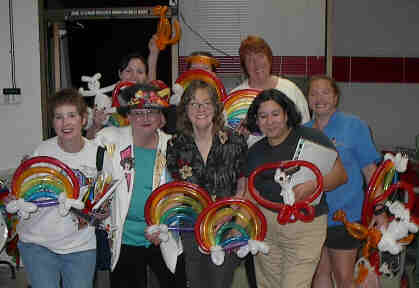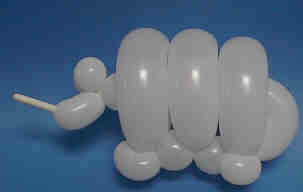160 Twisting Goes Mainstream
by Linda Berman
Hello everyone,

I am pleased to report that 160 twisting is gaining in popularity with twisters and decorators. My class on miniature
twisting was standing room only at The World Clown Association Convention in Mesa, Arizona last month. Many of the
participants had never tried twisting with 160s and were very excited about the ease of twisting and how quickly they can o
twist detailed designs.
I entered the new advanced division of the WCA balloon competition. I had to twist 4 sculptures within the one hour time
frame. One had to be one balloon design , one a multiple balloon design (all the same size), one a multiple balloon design
using 3″ or larger balloons (all the same size) and the last a “specialty balloon” any type or size and this design could
include drawing or eyes or other items attached to the balloon.
I specialize in multiple 160 designs so I asked the BHQ twisters list participants for ideas to expand my horizons for one
balloon designs. One person responded that he thought that Larry Moss’s bat would be a good option made with just 1 160.
I liked that idea and worked on some other options. Pickles the Clown had a balloon jam at her home in Orange County
the week before the convention. I shared my quest for a one balloon design with the participants. I showed them a 1
balloon armadillo design and with their input I finalized my competition entry. Thanks for all your assistance.
I entered the armadillo, the Koi fish, Bartholomew Bunny on a motorcycle (from my newest book) and a 350 frog modeled
after Lenny’s Frog (also from my newest book). The 350 design took more than 20 minutes but I was pleased to finish with
two minutes to spare. Then I stepped on the tablecloth and knocked all the designs on the floor. I was allowed to replace
the tablecloth and the sculptures.

At the awards banquet, I was awarded a silver medal for my effort (no gold was awarded). The other advanced competitor
was awarded the bronze medal.
Here are directions for the armadillo. I was going to use yellow but I found that the jewel tone balloons were more difficult
to work with for this design. I entered a light blue sculpture but I’ve attached a white example. Yes, I know that a real
armadillo has a fairly long tail, but this design does look like an armadillo. I’ve sold several at one of my regular events
while I was practicing for the competition.
Materials: 1 opaque 160q
Inflate the balloon leaving about 6″ uninflated. Twist 2 1″ pinch twists for the front feet. Next twist a 7″ fold twist. Gently
pull on both sides of the twist to slightly enlarge the opening. Next twist a 1″ bubble. Then twist another 7″ fold twist.
Gently pull on both sides of the twist to slightly enlarge the opening. Next twist a 1″ bubble. Then twist a 3rd 7″ fold twist.
Gently pull on both sides of the twist to slightly enlarge the opening. Then twist 2 1″ pinch twists for the back feet.
Carefully insert the remaining balloon through the 3 fold twists. Then twist 2 3/4″ bubbles for the eyes. You should have
about 1″ of uninflated balloon. Carefully curve the remaining inflated balloon up. You can add eyes with a marker or use
sticker eyes.
Speaking of sticker eyes:
I found a great resource for colored “wiggle eye” stickers. The company that makes them is Chenille Kraft. They only sell
to local dealers. But you can go to www.chenillekraft.com and do a search by zip code for your local dealer. The part # is
3403-01 for multi-color peel and stick wiggle eyes. They come on a roll of 1,000 stickers. I called my local dealer and had
them order several rolls the next time they placed an order with Chenille Kraft. Kids and adults love the colorful eyes and
they are the perfect size for 160 designs and you don’t have to worry about anyone taking off the eyes and swallowing
them.
Decorators Learning 160 Twisting
I had fun teaching another introductory 160 twisting class at All American Balloon Supply in Santa Ana, CA last month.
I’ve enclosed a photo of some of the participants with their designs. They quickly learned the basic twists and were soon
sculpting with 160s. Then they learned the raisin twist and made the Easter Bunny with rounds and 160s that I described in
a previous column. They are very excited about twisting and what new options they have for decor.
160 Twisting at TJam ’03
I am very pleased to announce that I have been invited to be one of the featured lecturers at TJam ’03 next February. Tom
asked me to present 3 lectures on miniature twisting. What would you like to learn? I am thinking of one lecture on very
detailed designs, another on speed twisting for lines and restaurants, and a third on wearable miniatures but I am very
interested in your input. I hope to have another book ready to debut at the event. What would you like to see? In addition to
a new twister book, I am planning on a book aimed at decorators.
See you next month,
Linda
You can contact me at [email protected] or [email protected] or at (626)581-7690. I live in Southern
California in the Pacific Daylight Time Zone. You can write to me at PO Box 50574, Pasadena, CA 91115 USA.